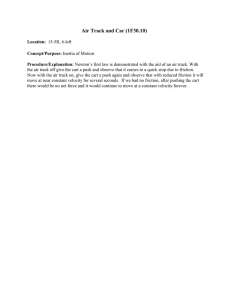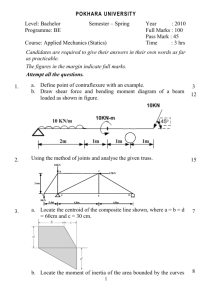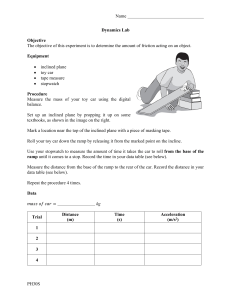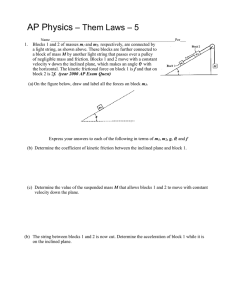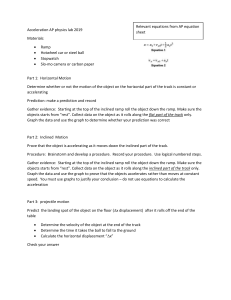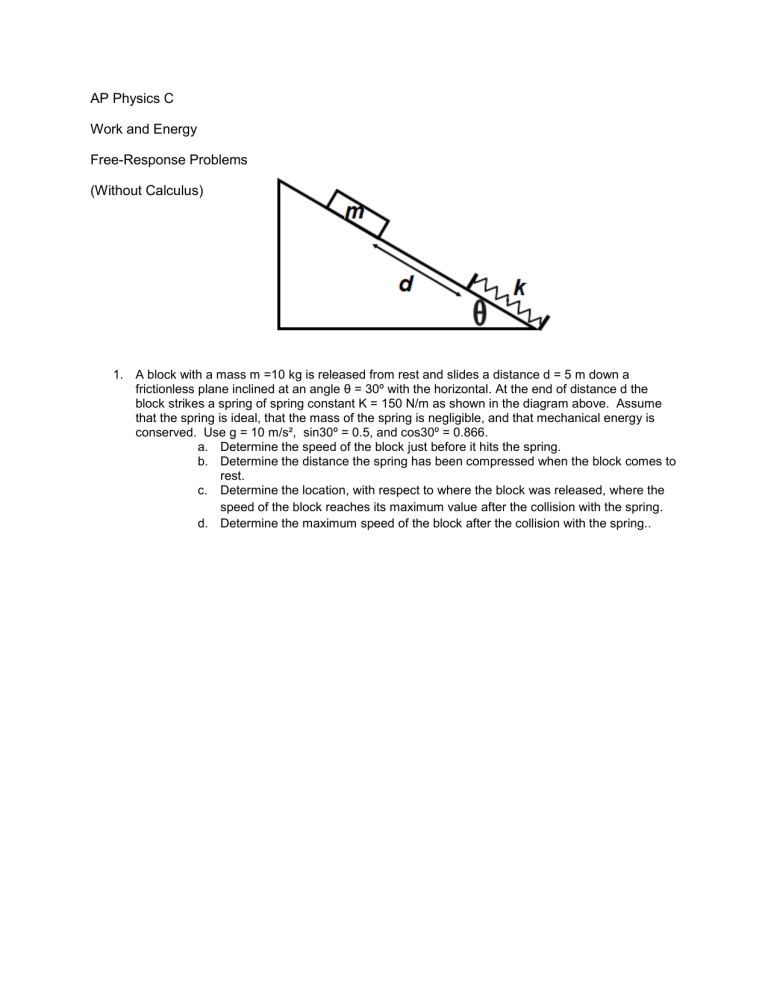
AP Physics C Work and Energy Free-Response Problems (Without Calculus) 1. A block with a mass m =10 kg is released from rest and slides a distance d = 5 m down a frictionless plane inclined at an angle θ = 30º with the horizontal. At the end of distance d the block strikes a spring of spring constant K = 150 N/m as shown in the diagram above. Assume that the spring is ideal, that the mass of the spring is negligible, and that mechanical energy is conserved. Use g = 10 m/s², sin30º = 0.5, and cos30º = 0.866. a. Determine the speed of the block just before it hits the spring. b. Determine the distance the spring has been compressed when the block comes to rest. c. Determine the location, with respect to where the block was released, where the speed of the block reaches its maximum value after the collision with the spring. d. Determine the maximum speed of the block after the collision with the spring.. 2. A small block with a mass m is released from rest at the top of frictionless sphere of radius R. a. In terms of m, g, R, and θ determine the following: i. The kinetic energy of the block while it is sliding on the sphere. ii. The centripetal acceleration of the block. iii. The tangential acceleration of the block. b. Determine the angle θ at which the block leaves the sphere. c. Determine the height h above the ground level at which the block leaves the sphere. 3. A small block of mass m = 0.5 kg is released from rest at the top of inclined ramp at H = 2 m above the ground level. The ramp has a circular section of radius r = 0.5 m and another small inclined section with a maximum height h = 0.3 m at θ = 37 ̊above the horizontal. The friction force is negligible as the block slides down the ramp. a. Find the speed of the block at the top of the circular section of the ramp. b. Find the normal force on the block when it is at the top of the circular section of the ramp. c. Find the speed of the block at the bottom of the circular section of the ramp. d. Find the normal force on the block when it is at the bottom of the circular section of the ramp. e. When the block leaves the ramp it flies as a projectile. Find the maximum horizontal range and the maximum height reached by the block. 4. A small box with a mass m = 0.2 kg is released from rest at the top of a curved section of a track that is one quarter of a circle with a radius R = 1.5m. When the box reaches the bottom of the curved track it then slides on a rough horizontal section of the track. The coefficient of kinetic friction between the box and the horizontal section is 0.2. Ignore friction on the curved section of the track. a. Find the velocity of the box at the bottom of the curved section of the track. b. Find the stopping distance of the box on the horizontal section of the track. c. If the friction on the curved section of the track is present, how would it change the answer to part (b)? 5. A small 0.5 kg is attached to a free end of a spring with a spring constant k = 100 N/m. Initially, the spring is compressed by a distance x = 20 cm and the block is held at rest. When the block is released it travels a distance L = 50 cm before reaching the bottom of an inclined plan with an angle θ = 30 ̊ above the horizontal. There is no friction between the block and the surface. a. What is the velocity of the block just before it reaches the bottom of the inclined plan? b. How high along the incline will the block move? c. If the surface and the inclined plane are not frictionless and the coefficient of kinetic friction is 0.02, what are the new answers for parts (a) and (b)? 6. A force F is applied to a 0.5 kg PASCO lab cart which moves along a straight track. The relationship between the force and the position of the cart is presented by the graph, as shown above. Assume that at time t = 0s, the cart is at rest where v0 = 0. a. Calculate the work done by the force when the cart moves from x = 0 m to x = 5 m. b. Calculate the change in kinetic energy during the same interval. c. Calculate the velocity of the cart at x = 5 m. d. Calculate the work done by the force when the cart moves from x = 5 m to x = 7 m. e. Is there any change in kinetic energy during this interval? Explain. f. Calculate the work done by the force when the cart moves from x = 7 m to x = 10 m. g. Calculate the net work done on the cart. h. Calculate the velocity of the cart at x = 10 m. 7. A spring gun is placed at the end of a tabletop. Initially, a spring with a spring constant K is compressed by a distance X and is then released. As a result, a marble with a mass m gains some horizontal velocity and flies off the table. a. What is the velocity of the marble at the edge of the table? b. How long will it take for the marble to move from the tabletop to the floor? c. How far from the table will the marble hit the floor? 8. A small cube moves at a constant velocity v = 8.5 m/s on the smooth horizontal floor until it reaches the bottom of an inclined plane at θ = 37 ̊above the horizontal. The cube slides up the inclined plane and covers a distance L = 2 m before leaving the incline. a. Calculate the velocity of the cube at the end of the inclined plane. b. Find the distance from the base of the inclined plane where the cube hits the floor. c. If the friction is not ignored, how would it change the answers to (a) and (b)? Answer-Key 1. A. 7.07 m/s B. 1.82m C. 5.33m D. 7.18m/s 2. A. I. 𝑚𝑔𝑅(1 − cos 𝜃) II. 2𝑔(1 − cos 𝜃) III. 𝑔 sin 𝜃 2 3 B. 𝜃 = cos −1 ( ) C. 3. 5 𝑅 3 A. 4.47m/s B. 14.98N C. 6.32 m/s D. 44.94N E. Height = 0.92m Range = 2.79m 4. A. 5.48m/s B. 7.51m C. It would lower the answer to B. 5. A. 2.83m/s B. 0.4m C. (A) would become 2.77m/s, and (B) would become 0.39m 6. A. 14J B. 14J C. 7.48 m/s D. 0J E. No. Work is equal to the change in Kinetic Energy. Work is zero, so change in KE is zero. F. -4.5J 7. 8. G. 9.5J H. 4.24m/s A. 𝑣 = 𝑥√ B. t=√𝑔 C. 𝐷 = 𝑥√ 𝑚𝑔 𝑘 𝑚 2𝐻 2𝐻𝑘 A. 6.34m/s B. 5.37m C. Both a. and b. would decrease

